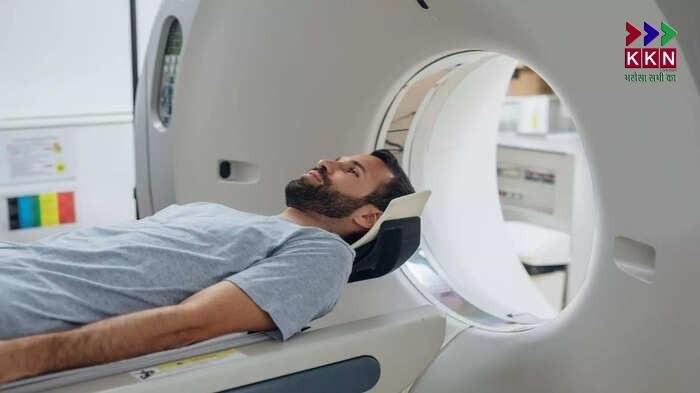
A 61-year-old man tragically lost his life inside an MRI room in New York after he was pulled violently into the machine due to a heavy metal chain around his neck. The powerful magnetic force of the MRI scanner dragged him across the room, leading to fatal injuries.
The horrifying incident occurred while the machine was already in use, scanning another patient. Unaware of the risk, the man entered the MRI suite wearing a chain reportedly weighing around 20 pounds (approximately 9 kilograms). The magnetic pull of the MRI unit latched onto the chain and forcefully dragged the man into the machine, resulting in a fatal impact.
How the Incident Unfolded in the MRI Room
According to reports, the deceased man has been identified as Keith McAlister. He had accompanied his wife, who was undergoing an MRI scan at the time. As she lay on the MRI table, she requested a technician to call her husband to assist her in getting up after the scan. The technician allowed McAlister to enter the room, unaware or unmindful of the large metal chain around his neck.
The MRI machine was active when McAlister stepped into the room. The powerful magnets instantly responded to the metal chain, yanking him toward the machine. The sudden force caused him to strike the equipment hard. His wife, who witnessed the entire incident, screamed for help and pleaded with the staff to shut down the machine. However, everything happened so fast that no immediate action could prevent the impact.
She later recounted the terrifying moment, saying he waved goodbye with his hand just before collapsing. The force of the magnet was so strong that even she and the technician together struggled to free him from the grip of the machine.
Aftermath and Hospital Response
After the emergency team managed to extract him from the MRI device, McAlister went into cardiac arrest. Despite immediate medical attention and being rushed to the hospital, he could not survive the trauma. He passed away the next afternoon.
The grieving wife questioned the hospital staff and technicians, blaming them for allowing her husband into the MRI room with a visible metal object. She argued that proper safety protocols were not followed and accused the staff of negligence. The investigation into the exact sequence of events and any procedural violations is ongoing.
Past Incidents Raise Safety Concerns
This tragedy is not the first time a fatal accident has occurred due to magnetic interference inside an MRI room. In a similar incident in 2001, a six-year-old child lost his life at a New York medical center. An oxygen tank was accidentally brought into the MRI suite. The magnetic pull dragged the tank toward the machine, striking the child fatally.
The family of the child later received approximately ₹24 crore in compensation, highlighting the severe consequences of safety lapses in environments involving strong magnetic equipment.
Understanding the Power of MRI Machines
MRI, or Magnetic Resonance Imaging, is a widely used and highly advanced diagnostic technique in modern medicine. It works on the principle of magnetic fields and radio waves to create detailed images of internal organs. However, what many people don’t realize is just how powerful the magnetic field inside an MRI machine can be.
The magnets inside an MRI scanner are incredibly strong — typically 1.5 to 3 Tesla in clinical settings, which is tens of thousands of times stronger than the Earth’s magnetic field. These machines are capable of pulling metallic objects like chains, watches, belts, mobile phones, keys, wheelchairs, and even large medical cylinders with immense force.
According to medical experts, an MRI machine can drag a metal wheelchair across the room in seconds. That’s why strict protocols are enforced in hospitals and diagnostic centers to prevent any metallic items from entering the MRI suite.
What Must Be Avoided Before Entering an MRI Room
Before anyone enters an MRI room, they are typically screened for any metal objects. Patients and companions are required to remove jewelry, metal accessories, belts, and any items that could pose a magnetic risk. Even clothing with metallic threads or underwire bras are considered hazardous.
Hospitals often have checklists and metal detectors to ensure safety. However, this recent tragedy has again raised concerns about how such precautions are being enforced in practice. The presence of even a small metal item can cause serious injury or equipment damage.
Patients, attendants, and medical personnel must all follow clear guidelines before approaching the MRI room. If there’s any doubt, consultation with a technician or radiologist is essential.
Importance of Technicians in MRI Safety
Technicians play a critical role in maintaining safety inside MRI facilities. They are responsible not only for operating the machine but also for ensuring that all individuals entering the room are completely free from metallic items. This includes proper communication with patients, screening procedures, and denying access if safety risks are visible.
In the New York case, the key question remains why the technician permitted McAlister to enter the active MRI room while he was wearing a metal chain. Whether this was due to miscommunication, oversight, or a breakdown in standard operating procedures, it is now under official review.
Why MRI-Related Accidents Continue to Happen
Despite being a routine medical procedure, MRI scans still pose risks when safety measures are ignored. The primary danger is the magnetic force, which remains active and powerful as long as the machine is turned on. Even non-medical staff or relatives accompanying patients are sometimes unaware of these risks.
In many cases, staff members become too accustomed to the routine and may lower their guard, especially if pressure or urgency is involved. Lack of training, failure to follow checklists, or assuming someone “knows better” can quickly lead to dangerous situations. This incident once again highlights the need for reinforced training and patient education.
Preventing Future MRI Accidents: Lessons to Learn
Medical centers need to implement stricter policies and provide constant education to both staff and patients. Proper signage, verbal warnings, and physical barriers should be standard in MRI units. No one should be allowed inside without a thorough inspection.
Technological solutions can also assist in minimizing risks. For example, some centers are adopting ferromagnetic detection systems that automatically alert staff when a metal object is present near the MRI room. These tools can act as a final line of defense before tragedy strikes.
The public should also be made more aware of how dangerous the MRI environment can be when safety rules are ignored. Even something as common as a metal pen in a pocket or a necklace around the neck can become lethal.
Patient Safety and Legal Accountability
Incidents like these often result in legal proceedings and liability claims. If negligence is proven, hospitals and individual staff members may be held responsible. In this case, the victim’s wife has already expressed dissatisfaction with the handling of the situation.
Legal experts point out that patient safety is a hospital’s top priority, and failing to enforce MRI safety protocols could be seen as a breach of duty. Depending on the investigation’s findings, lawsuits may follow, demanding answers and compensation.
The sudden death of Keith McAlister in an MRI room has left a deep scar on his family and raised critical questions for the medical community. While MRI machines are invaluable tools for diagnosis, they also carry risks that must be taken seriously.
This tragedy serves as a reminder that no amount of advanced technology can replace basic human attention to detail. The power of an MRI machine should never be underestimated. Strict adherence to safety protocols and proper staff training are the only ways to prevent such devastating accidents in the future.
For now, investigations continue, and many hope this incident will lead to reforms that make MRI rooms safer for everyone involved.


